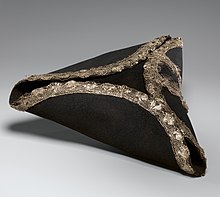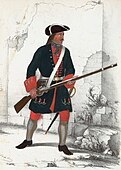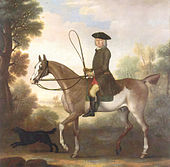Tricorne
 Italian tricorne hat, mid-18th century | |
| Type | Hat |
|---|---|
| Material | Animal fiber |
| Introduced | 17th century |
The tricorne or tricorn is a style of hat that was popular during the 18th century, falling out of style by the early 1800s, though not called a "tricorne" until the mid-19th century. During the 18th century, hats of this general style were referred to as "cocked hats". At the peak of its popularity, the tricorne varied greatly in style and size, and was worn not only by the aristocracy, but also as common civilian dress, and as part of military and naval uniforms.[1] Typically made from animal fiber, the more expensive being of beaver-hair felt and the less expensive of wool felt, the hat's most distinguishing characteristic was that three sides of the brim were turned up (cocked) and either pinned, laced, or buttoned in place to form a triangle around the crown. The style served two purposes: first, it allowed stylish gentlemen to show off the most current fashions of their wigs, and thus their social status; and secondly, the cocked hat, with its folded brim, was much smaller than other hats, and therefore could be more easily tucked under an arm when going inside a building, where social etiquette dictates that a gentleman should remove his hat. Tricornes with laced sides could have the laces loosened and the sides dropped down to provide better protection from the weather, sun, and rain.[2][3]
Tricornes had a rather broad
Tricornes ranged from the very simple and cheap to the extravagant, occasionally incorporating
History

The tricorne appeared as a result of the evolution of the broad-brim round hat used by Spanish soldiers in Flanders during the 17th century.[5] By pledging (binding) the brims, a triangular shape was obtained. This shape was favored by Spanish soldiers, as when standing at arms their muskets could be held at their shoulders right or left without hitting the hat brim. War broke out between France and Spain in 1667 over the Spanish Netherlands, and during the subsequent struggle its use spread to the French armies. The style was brought back to France, where its usage spread to the French population and the royal court of King Louis XIV, who made it fashionable throughout Europe, both as a civilian and military wear. By the end of the 17th century, the tricorne was popular in both civilian fashion and in military uniforms. They remained one of the predominant European styles of hat throughout the 18th century. In the United States, only the first five Presidents, from George Washington to James Monroe, wore this style of hat according to the fashion of the 18th century.[6][7] James Monroe earned the nickname "The Last Cocked Hat"[8] because of this.
The tricorne quickly declined in use at the end of the 18th century. It evolved into the bicorne,[9] which was widely used by military officers in Europe from the 1790s until World War I, not completely fading out of style until World War II. For enlisted soldiers, the tricorne was replaced by the shako at the turn of the 19th century, which had become the new dominant style of military headgear from 1800 on.[10] Also at the turn of the 19th century, as the fashionable hat for civilian men, the tricorne was overtaken by the top hat.[11] In 1917, the Women's Royal Naval Service introduced a smaller, modernised version of the tricorne for female officers.[12]
Modern usage and legacy
-
Alabardero (Halberdier) of the Spanish Royal Guard
-
Royal court of the Netherlands
-
Tricorne worn by U.S. Army Old Guard Fife and Drum Corps
-
Chelsea Pensioners wearing their tricorne hats
-
Lord Mayor of Plymouth, 2009
Tricornes survive today as part of the traditional dress of the
In the United States, the tricorne is associated with the
In
In France, synagogue officiants (usually not rabbis), wear the tricorne on formal occasions. In the French navy and air force, tricornes are still worn by women as a piece of uniform.
The tricorne is a key feature in the
In Canada, the tricorne is part of the ceremonial wear of the Speakers, both in the federal Parliament and in some provincial legislatures. It is also part of the ceremonial dress for justices of the Supreme Court of Canada.
In 1981 the milliner
Gallery
-
Figure of Louis XIV c. 1685
-
Russian soldier, c. 1700
-
Charles Alexander, c. 1733–1737
-
Thomas Gage, 1743
-
Frederick the Great wearing a tricorne, c. 1750
-
Catherine the Great, c. 1760
-
Colonel George Washington, 1772
-
Lord Cornwallisat Yorktown
-
Charles III of Spain, c. 1786–88
-
The British Speaker of the House of Commons carrying his tricorne, 1906.
-
The Women's Royal Naval Service modernised version of the tricorne in 1942.
See also
- Beaver hat
- Bicorne
- Cap
- Chapeau
- List of hats and headgear
References
- ^ "Gentlemen of Fortune". Gentlemenoffortune.com. Retrieved 20 October 2017.
- ^ "Digital Collection -Tricorn Hat". Memorialhall.mass.edu. Retrieved 20 October 2017.
- ^ "Cocked Hats". Williamsburgmarketplace.com. Retrieved 20 October 2017.
- ^ "Archived copy". Archived from the original on 2008-12-17. Retrieved 2008-09-02.
{{cite web}}: CS1 maint: archived copy as title (link) - ^ Castells, Albert. "Los tercios viejos y la presencia española en Flandes", Espasa, Madrid, 1997
- ^ Digital History, Steven Mintz. "Digital History". Digitalhistory.uh.edu. Archived from the original on 23 July 2010. Retrieved 20 April 2010.
- ISBN 978-0-415-93951-5. Retrieved April 20, 2010.
- ^ Robert S. Summer. "James Monroe". Presidents of the United States. Retrieved 28 October 2014.
- ^ "Cocked Hat". Infoplease.com. Retrieved 20 October 2017.
- ISBN 0-7137-0482-9.
- ISBN 978-0896762138.
- ISBN 978-0891412830.
- ^ "Royal Hospital Chelsea". Chelsea-pensioners.co.uk. Retrieved 20 October 2017.
- ^ "About the Corps". Army.mil/fifeanddrum/about.com. Retrieved 20 October 2017.
- ^ http://people.zeelandnet.nl/tberry/hatpics/gc.JPG [bare URL image file]
- ^ "The Lord Mayor's Show". Lordmayorsshow.org. Retrieved 20 October 2017.
- ISBN 978-0719072079.
- ^ "Revolutionary War - Headgear". Revolutionarywararchives.org. Retrieved 20 October 2017.
- ^ "New England Patriots".
- ^ "New England Revolution". Revolutionsoccer.net. Retrieved 20 October 2017.
- ^ "University of Massachusetts Official Athletic Site - Football". Umassathletics.cstv.com. Retrieved 20 October 2017.
- ISBN 978-1409465232.
- ^ "Uniformes de carácter histórico". guardiareal.org. Retrieved 1 September 2019.
- ^ "John Boyd". The FMD - FashionModelDirectory.com.
External links
![]() Media related to Tricorne hats at Wikimedia Commons
Media related to Tricorne hats at Wikimedia Commons



















